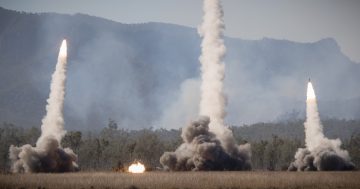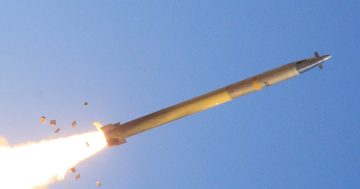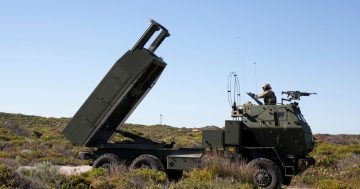
GMLRS rounds being fired from Australia, US and Singaporean HIMARS launchers during Exercise Talisman Sabre 2025. Photo: ADF.
Australia’s ambitions to develop a sovereign guided weapons production industry have taken another step forward with the signing of a joint statement of intent with the United States to enhance bilateral cooperation on local production.
The signing also included defence giant Lockheed Martin, and coincides with the opening of a new joint program office with the Pentagon in Huntsville, Alabama.
These events are part of the government’s $21 billion 10-year sovereign Guided Weapons and Explosive Ordnance (GWEO) Enterprise goal to establish local production of precision-guided weapons to increase local skills and defence exports, and to decrease Australia’s reliance on global supply chains.
Defence says the signing also opens opportunities for additional co-development programs and the production of long-range fires, beginning with variants across the Guided Multiple Launch Rocket System (GMLRS) family of munitions and Precision Strike Missiles (PrSM).
Australia is a cooperative development partner with the US Army on the Increment 2 anti-ship missile version of the PrSM.
These missiles are produced by Lockheed Martin, and are fired from M142 High Mobility Artillery Rocket Systems (HIMARS) launcher vehicles, the first 48 of which were delivered to the Australian Army earlier this year. The first firing of a PrSM from an Australian HIMARS was conducted in August.
The statement also acknowledges that, for guided weapons manufacturing in Australia to be a viable and sustainable capability, Australia will need to produce guided weapon quantities beyond the demands of the Australian Defence Force (ADF), meaning components produced here will likely be integrated into the US-led global supply chain.
HIMARS and GMLRS are operated by numerous US and allied forces, including Singapore, the UK, Germany, and many new customer countries that have ordered the system in the wake of its successful use against Russian forces in Ukraine.
Defence says Australia is on track for the production of the first GMLRS munitions before the end of 2025, and says there is a view to manufacturing more advanced weapons – possibly PrSM – in the future.
The joint program office in Huntsville will focus on the PrSM, and will be a dedicated facility and hub for coordination between Australia and the US on the acquisition, development, production and sustainment of the system.
Defence Industry Minister Pat Conroy is in the US for the signing of the statement and the opening of the joint facility, as part of a longer trip to meet senior officials from the Trump administration, members of Congress, and key defence industry leaders.
While in Washington DC, Mr Conroy will take part in an AUKUS defence industry update, and attend the Association of the United States Army (AUSA) Annual Meeting & Exposition.
“This statement of intent reaffirms the strength of our longstanding alliance with the United States and our mutual interest in contributing to regional and international security,” he said.
“This milestone is a clear demonstration of our shared commitment to building a resilient and interoperable industrial capacity for both Australia and the United States.
“The statement reflects the Albanese Government’s determination to accelerate the delivery of advanced capabilities that help keep Australians safe, while strengthening our defence industrial base.”
In a separate television interview, Mr Conroy confirmed the start of missile production in Australia by the end of the year.
“And that’s in a staged process where we will then begin production, or construction rather, of the Australian missile weapons complex,” he told SKY News.
“And the goal is to have a missile factory that can produce up to 4000 missiles, in this case [GMLRS] missiles that are being used in Ukraine right now. And that 4000 number is in excess of what we need for our own stockpiles.
“The plan is that we would also have the option of producing PrSM missiles in Australia as well,” he added.
“We’re starting with GMLRS, which is a simpler missile but still very effective, and then we would move on to the [PrSM] later on.”











